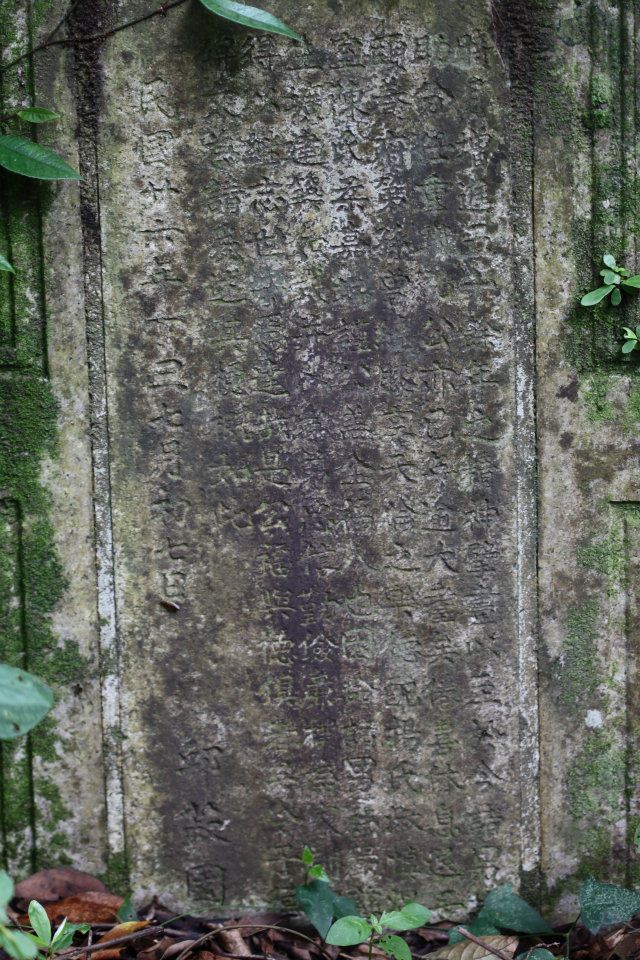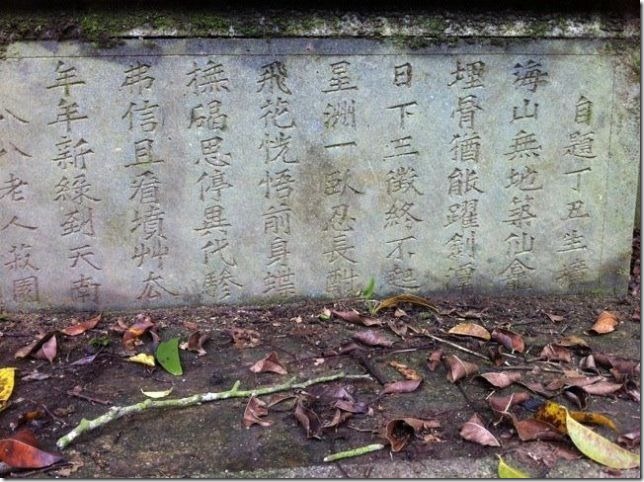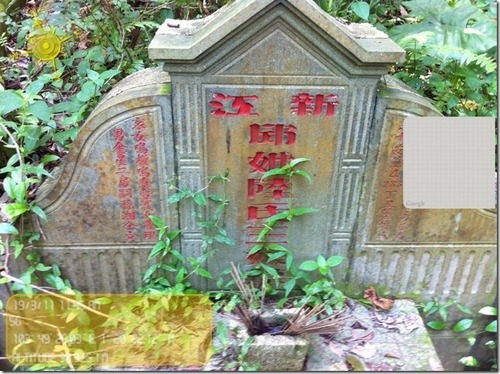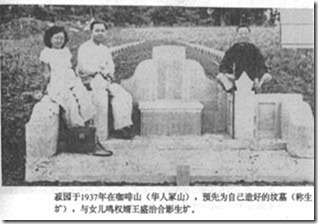Khoo Seok Wan – Poet, Scholar, Revolutionary, Romantic
19
几枚白石伴青珉,
小筑坟莹隔岁春
地下有灵相谅解,
迟工原是为家贫.
A few pieces of white rock accompany the green stone,
A little grave built but alas late one year
My dear I hope you can understand the reason,
I am late to build because of my poverty.
(Khoo Seok Wan (1874-1941) in memory of his wife, Lu Jie (陆结)
He was a Confucian scholar, a political activist in revolutionary China, a prominent community leader in Singapore and an early advocate for education for girls who helped set up the Singapore Chinese Girls School.
Born into a wealthy merchant family, Khoo’s fortunes waxed and waned because of his extravagant life style ( he was known to be a generous host) and the over extension of his funding activities to revolutionary causes. But embedded in his life is a love story which captured the heart of Bukit Brown resident tomb whisperer Raymond Goh; he was determined to find his grave.
When Khoo Seok Wan’s wife died in 1936 at the age of 44, his fortunes were on the wane and he was bankrupted. He could not afford a tombstone for his wife whom he buried in Bukit Brown. So he buried his own tooth with her and when he could afford it the next year also constructed his own tombstone in preparation to be reunited her one day. The poem was penned to mark the occasion.
Khoo was born in Fujian, China, and followed his mother to Macau before he joined his father in Singapore in 1881. His father, Khoo Cheng Tiong (邱正忠), was a successful rice merchant and prominent community leader in Singapore. Khoo was schooled in traditional Confucian education, and when he was 15 years old, he went back to his hometown to prepare for the Chinese imperial examinations. He passed the district and provincial examinations to attain the level of a juren (举人) that qualified him as a candidate for the central government imperial examinations in Beijing, but he failed in that attempt in 1895 and returned to Singapore.
Khoo suffered from leprosy and lived his last years on the generosity of his friends. He died in Singapore at the age of 68 on 1 December 1941.
He was buried in Bukit Brown cemetery beside his wife. Earlier this year, Raymond Goh finally tracked down the tombstone Khoo built for himself and his wife from records in the Burial Register lodged with the National Archives. Khoo Seok Wan’s tomb is in Blk 4 Section C, is in the path of new dual 4 lane road.

Khoo Seok Wan “live” tomb, inscribed on the altar is his epithet which he penned himself (photo:Raymond Goh)
海山無地築仙龛
… How can the buried bones leap across the sword lake
日下三徵終不起
Even if you beckon 3 times, I could no longer arise
That lay in Singapore enduring long thirst
Flying flowers realized their butterfly past life
Caressing the epigraph, thoughts stop and future generations
If you don’t believe just look at the tomb grass
88 old man Seok Wan
I stand before him, silent, in respect and awe.
His genes embedded in every cell of mine
We are bonded though the course of time.
A white stake declares a foreboding future
His eyeless sockets shedding copious tears
That eight lane highway: unspoken fears
“Could you not ask them to let us rest in peace”
His silenced tongue in eloquence loudly says
His bony hands grasp me in one last fond embrace.
by Lim Su Min 林蘇民 in tribute.
The prolific Khoo is responsible for composing epithets for luminaries buried at Bukit Brown. Among them the father of Khoo Teck Puat, Khoo Yang Thin. His epithet is an exhortation to the descendents through a list of things to do to live a good, honest and honorable life.

Discernible beneath the grime there is true grit Khoo Yang Thin’s grave can be found in group 12 on the map (photo Perry Tan)
Another example is the epithet for Wee Teck Seng’s tomb (just below Gan Eng Seng):
Khoo Seok Wan was also responsible for popularizing the term Sin Chew which is a sobriquet for “Singapore” (translated) Khoo writes: Singapore is an island surrounded by the sea, and with vessels and boats large and small anchored around it; the glitter of artificial lights at night are like a crown of illuminated stars (“星”) when viewed from afar. “洲” (zhou, island) and “舟” (zhou, boat) are homonyms: while the boat lights are like stars, those on the island are like the Big Dipper to accentuate the constellation. This is why the term “Sin Chew” is widely known by folks here and afar.
Editor’s note: In the first posting of this article, Lim Su Min our tea master, believed Khoo Seok Wan to be his great great grandfather based on initial evidence. Further investigation has shown this trail to be false. But in the spirit of paying tribute to Khoo Seok Wan the poet, we are leaving in this post the poem composed by Su Min.






What a wonderful discovery!
Precious historical information seems to be unearthed with each passing week at Bukit Brown.
Probably the one and only Singaprean Ju-ren (舉人)from the Imperial Examinations.
A scholar, renowned poet, educationist and ex-tycoon all rolled into one!
Most surprisingly, this man was even linked to the late Ching reformers Kang You Wei (康有為) and Liang Qi Chao ( 梁啟超) as leader of the Baohuanghui (保皇會) in Singapore!!
Even the internet don’t explain how the term “星洲” came about!
Thanks Raymond! Keep uncovering the stories behind the souls of Bukit Brown!!
I found from the NLB newspaper archives the name of Khoo Siok Wan’s wife spelt as :
Look Kit Sia & Look Kia Sit.
I cant read Chinese, so which of the above names is correct?
Thanks!
Hi Soon Hoe,
Khoo Seok Wan has two wives: Wang Mei (王玫), Lu Jie (陆结):
In 1891 November,Khoo Seok Wan married Wang Mei at the age of 18. She is quite a scholar herself but unfortunately died in Sept, 1892. At age 20 he remarried Lu Jie (sound likes Look Kit) I think the Sit refers to the Chinese 氏 Si which refers to the madam surname so Lu Jie would be 陆氏. Hope this answer your question.
Hello Khoo Ee Hoon,
Thank you. So the anglicized name should read as Look Kit Sit instead.
I wonder if you could help with this query:
http://newspapers.nl.sg/Digitised/Article/straitstimes19230629.2.17.aspx
Khoo Seok Wan has 2 brothers & 4 sisters.
We know of Khoo Heng Neo. Do you know the names of the other sisters?
http://wc.rootsweb.ancestry.com/cgi-bin/igm.cgi?op=GET&db=lawrencetan&id=I7109
Thank you!!
soonhoe
Hi my grandma name is Khoo Choo Neo and my grandpa name is William Yeo Wee Set. They are cousins, my Grandma got 3 brothers and 4 sisters regarding the picture that my late dad left us. I wonder if they were their families as my late dad did mentioned to us that his latema families comes from a rich families, they were hokkien+peranakan. I really want to know more about them hopefully this link can help me to know more further about the families.
Dear Bahriah,
Thanks for reaching out to us. We are a small volunteer group and your request goes beyond what we are able to do as tracing genealogy is complex. You can start by looking at resources from National Archives of Singapore http://eresources.nlb.gov.sg/newspapers/ and search for known names in your family tree for articles which may hold further clues. Best of luck.
Hi Bahriah, I am researching on Khoo Seok Wan and his descendents. Please get in touch with me. My email address is timothy.toh.he@gmail.com. Thank you.
Hi Khoo Ee Hoon,
OOps, I forgot, Raymond sent me a picture of Mdm Yeo’s tombstone .
I can only see 3 daughters’ names on the left, viz. “xing niang”, “yong shi” & “qing ye”.
I suppose “xing niang” refers to Heng Neo married to See Tiong Wah.
There are 3 more son-in-laws in the notice.
Thank you,
soonhoe
HI Soon Hoe,
Khoo Cheng Tiong has a total of 5 wives (some sources said 7) Mdm Yeo Geok Keng is one of his wife. In my current record he has 4 sons and 5 daughters. The sons are, Khoo Teck Siong, Khoo Teck Kheng, Khoo Teck Him and Khoo It Sim. The son-in-laws are Lim Chan SIn, See Teong Wah, Tay Boon Tat and Ong Keng Yong. About the daughters, I only have Khoo Heng Neo in record, the rest is pretty hard to guess who is married to whom.
Will post more information as they come in. Please also share with us if you have other sources.
Best regards.
Hi Ee Hoon,
I’m so glad I came across your post. My uncle has mentioned that we are related to Khoo Cheng Tiong via my great Grandmother’s (Khoo Liew Neo) side of the family. Her father was Khoo Teck Keng (I believe also spelt Khoo Teck Kheng). Your post has finally given me link I need. I would be really happy if you could contact me to share our research if possible.
Best regards
Kelvin
Hi Kelvin, I am researching on Khoo Seok Wan and his descendents. Please get in touch with me. My email address is timothy.toh.he@gmail.com. Thank you.
One character is missing from “海山無地築仙X”
Three characters are missing from this sentence “弗信且看墳XXX”.
Thank you Chengmin Wang. The missing characters have been added in.